Parameters Influencing on Electric Vehicle Range
Abstract
1. Introduction
2. Range Anxiety
- Cognitive level: manifested by negative beliefs related to the range, e.g., fear of running out of energy and not being able to reach the destination.
- Emotional level: causing, e.g., anxiety, nervousness, or fear in the situation.
- Behavioral level: expressed by a change in a driver’s behavior that reduces immediate anxiety by increasing feelings of safety and control. Demonstrated, for example, by certain actions such as changing driving style to save energy or frequently checking the on-board computer readouts (for range, energy level, position), or even aggressive behavior manifested, for example, by tapping fingers on the steering wheel, shouting, honking, or aggressive gestures.
- Physiological level: manifested in the body’s response to the situation, e.g., increased blood pressure, heart rate, heart rate variability, cortisol level, pupil diameter, respiratory rate, etc.
3. Factors Affecting the Range of an Electric Vehicle
4. Range Estimation Models in Electric Vehicles
- Dynamic range estimator (DRE): In addition to the route parameters, the driver’s behavior is taken into account for estimating the energy consumption. This is represented by the acceleration value and the efficiency of the driver, and the use of additional electric auxiliary equipment (e.g., air-conditioning) [83,86,87].
- Big data analysis. This includes a mathematical model that involves a complex process of examining large data sets to discover certain patterns, correlations, or trends that are used to estimate some assumed variable. In estimating the range of an electric vehicle using this method, three steps are distinguished: (1) determining the route profile based on GPS data; (2) estimating the battery life considering the relationship of internal resistance and SOH; (3) estimating the energy consumption based on the selected route and the energy capacity of the battery, and calculating the range based on these values [88].
5. Methodology of Simulation
5.1. Vehicle
5.2. Driving Cycles
- Infrastructure, e.g., location and position of traffic lights, types of intersection, location of bus stops, road type (urban, suburban, highway).
- Vertical profile of the route.
- Traffic volume.
- Dynamic properties of the car.
5.3. AVL Cruise Vehicle Simulation Program
- obtain a reliable and accurate fuel consumption forecast of the developed vehicle;
- analyze energy flow, power distribution, and losses in the power train, from the power source to the wheels;
- find the optimum balance between fuel consumption, emissions, and the drive’s traction properties;
- analyze torsional vibrations of flexible chassis (under dynamic load);
- analyze temperature distribution in power train components.
6. Results
- in three driving cycles with different traffic dynamics (NEDC, WLTC, highway cycle);
- at different initial battery charge levels (40%, 50%, 60%, 70%, 80%, 90%, 100%);
- at different loads (50, 100, 150, 200, 250 kg);
- at different ambient temperatures (−20 °C, −10 °C, 0 °C, 10 °C, 20 °C, 40 °C).
7. Discussion
8. Conclusions
Author Contributions
Funding
Institutional Review Board Statement
Informed Consent Statement
Data Availability Statement
Conflicts of Interest
References
- New Passenger Car Registrations in the EU by Alternative Fuel Type, European Automobile Manufacturers’ Association (ACEA). Available online: https://www.acea.be/press-releases/article/fuel-types-of-new-cars-electric-10.5-hybrid-11.9-petrol-47.5-market-share-f (accessed on 20 March 2021).
- Vehicle in Use; ACEA Report; European Automobile Manufacturers’ Association (ACEA): Brussels, Belgium, 2021.
- Global EV Outlook 2020 Entering the Decade of Electric Drive? International Energy Agency (IEA): Paris, France, 2020.
- The Global Electric Vehicle Market in 2021: Statistics & Forecasts. Available online: https://www.virta.global/global-electric-vehicle-market (accessed on 20 March 2021).
- Turoń, K.; Sierpiński, G. Car-Sharing in Urban Transport Systems—Overview of Europe and Asia. In Challenges of Urban. Mobility, Transport. Companies and Systems; (Springer Proceedings in Business and Economics); Springer: Berlin/Heidelberg, Germany, 2019; pp. 89–99. [Google Scholar] [CrossRef]
- Münzel, K.; Boon, W.; Frenken, K.; Blomme, J.; van der Linden, D. Explaining carsharing supply across Western European cities. Int. J. Sustain. Transp. 2019, 14, 243–254. [Google Scholar] [CrossRef]
- Ramos, É.M.S.; Bergstad, C.J.; Chicco, A.; Diana, M. Mobility styles and car sharing use in Europe: Attitudes, behaviours, motives and sustainability. Eur. Transp. Res. Rev. 2020, 12, 13. [Google Scholar] [CrossRef]
- Study on Passenger Transport by Taxi, Hire Car with Driver and Ridesharing in the EU, European Commission Directorate-General for Mobility and Transport. 2016. Available online: https://ec.europa.eu/transport/modes/road/studies/study-passenger-transport-taxi-hire-car-driver-and-ridesharing-eu_cs (accessed on 21 March 2021).
- Mathieu, L.; Poliscanova, J. Mission (Almost) Accomplished. Carmakers’ Race to Meet the 2020/21 CO2 Targets and the UE Electric Cars Market; Transport & Environment: Brussels, Belgium, 2020. [Google Scholar]
- Merkisz-Guranowska, A.; Maciejewski, M. The Implementation of the Electric Taxi Fleet in the City of Poznan, Poland. WIT Trans. Built Environ. 2015, 146, 243–254. [Google Scholar] [CrossRef]
- Moniot, M.; Rames, C.; Burrell, E. Feasibility Analysis of Taxi Fleet Electrification using 4.9 Million Miles of Real-World Driving Data. SAE Tech. Pap. 2019, 1–10. [Google Scholar] [CrossRef]
- Tamis, M.; van den Hoed, R. Moving a Taxi Sector to Become Electric: Characterizing Taxi Drivers Interested in Purchasing a Full Electric Vehicle. World Electr. Veh. J. 2020, 11, 20. [Google Scholar] [CrossRef]
- Wang, G.; Zhang, Y.; Fang, Z.; Wang, S.; Zhang, F.; Zhang, D. FairCharge: A Data-Driven Fairness-Aware Charging Recommendation System for Large-Scale Electric Taxi Fleets. Proc. ACM Interact. Mob. Wearable Ubiquitous Technol. 2020, 4, 25. [Google Scholar] [CrossRef]
- Hall, D.; Moultak, M.; Lutsey, N. Electric Vehicle Capitals of the World: Demonstrating the Path to Electric Drive. International Council on Clean Transportation. 2017. Available online: https://theicct.org/publications/EV-capitals-of-the-world (accessed on 21 March 2021).
- Maffei, L.; Masullo, M. Electric Vehicles and Urban Noise Control Policies. Arch. Acoust. 2014, 39, 333–341. [Google Scholar] [CrossRef]
- Pallas, M.-A.; Kennedy, J.; Chatagnon, R.; Berengier, M.; Czuka, M.; Conter, M.; Muirhead, M. Towards a model for electric vehicle noise emission in the European prediction method CNOSSOS-EU. Appl. Acoust. 2016, 113, 89–101. [Google Scholar] [CrossRef]
- Łebkowski, A. Electric Vehicles—The Sound Of Silence. Masz. Elektr. Zesz. Probl. Nr 1 2016, 109, 155–159. [Google Scholar]
- Bekker, A. Influences of Electric Propulsion on Vehicle Vibro-acoustics. R D J. South. Afr. Inst. Mech. Eng. 2014, 30, 47–54. [Google Scholar]
- Szumska, E.; Jurecki, R.; Pawełczyk, M. Assessment of Total Costs of Ownership for Midsize Passenger Cars with Conventional and Alternative Drive Trains. Commun. Sci. Lett. Univ. Zilina 2019, 21, 21–27. [Google Scholar] [CrossRef]
- Hagman, J.; Ritzén, S.; Janhager Stier, J.; Susilo, Y. Total cost of ownership and its potential implications for battery electric vehicle diffusion. Res. Transp. Bus. Manag. 2016, 18, 11–17. [Google Scholar] [CrossRef]
- Kumar, P.; Chakrabarty, S. Total Cost of Ownership Analysis of the Impact of Vehicle Usage on the Economic Viability of Electric Vehicles in India. Transp. Res. Rec. 2020, 2674, 563–572. [Google Scholar] [CrossRef]
- Letmathe, P.; Suares, M. A consumer-oriented total cost of ownership model for different vehicle types in Germany. Transp. Res. Part D Transp. Environ. 2017, 57, 314–335. [Google Scholar] [CrossRef]
- Stevic, Z.; Radovanovic, I. Energy Efficiency of Electric Vehicles, New Generation of Electric Vehicles. In New Generation of Electric Vehicles; Stevic, Z., Ed.; Intech-Open: Belgrade, Serbia, 2012; pp. 93–134. [Google Scholar] [CrossRef]
- Mirchevski, S. Energy Efficiency in Electric Drives. Electronics 2012, 16, 46–49. [Google Scholar] [CrossRef]
- Gu, J.; Ouyang, M.; Lu, D.; Li, J.; Lu, L. Energy efficiency optimization of electric vehicle driven by in-wheel motors. Int. J. Automot. Technol. 2013, 14, 763–772. [Google Scholar] [CrossRef]
- Kobayashi, S.; Plotkin, S.; Ribeiro, S.K. Energy efficiency technologies for road vehicles. Energy Effic. 2009, 2, 125–137. [Google Scholar] [CrossRef]
- Han, J.; Vahidi, A.; Sciarretta, A. Fundamentals of energy efficient driving for combustion engine and electric vehicles: An optimal control perspective. Automatica 2019, 103, 558–572. [Google Scholar] [CrossRef]
- Albatayneh, A.; Assaf, M.; Alterman, D.; Jaradat, M. Comparison of the Overall Energy Efficiency for Internal Combustion Engine Vehicles and Electric Vehicles. Environ. Clim. Technol. 2020, 24, 669–680. [Google Scholar] [CrossRef]
- Ehsani, M.; Gao, Y.; Emadi, A. Modern Electric, Hybrid Electric, and Fuel Cell Vehicles—Fundamentals, Theory, and Design, 2nd ed.; CRC Press: Boca Raton, FL, USA, 2017. [Google Scholar]
- Liu, H.; Chen, X.; Wang, X. Overview and Prospects on Distributed Drive Electric Vehicles and Its Energy Saving Strategy. Przegląd Elektrotechniczny Electr. Rev. 2012, 88, 122–125. [Google Scholar]
- Wang, J.; Besselink, I.; Nijmeijer, H. Electric Vehicle Energy Consumption Modelling and Prediction Based on Road Information. World Electr. Veh. J. 2015, 7, 447–458. [Google Scholar] [CrossRef]
- Musabini, A.; Nguyen, K.; Rouyer, R.; Lilis, Y. Influence of Adaptive Human–Machine Interface on Electric-Vehicle Range-Anxiety Mitigation. Multimodal Technol. Interact. 2020, 4, 4. [Google Scholar] [CrossRef]
- Yuan, Q.; Hao, W.; Su, H.; Bing, G.; Gui, X.; Safikhani, A. Investigation on Range Anxiety and Safety Buffer of Battery Electric Vehicle Drivers. J. Adv. Transp. 2018, 2018, 8301209. [Google Scholar] [CrossRef]
- Jung, M.F.; Sirkin, D.; Gür, T.M.; Steinert, M. Displayed Uncertainty Improves Driving Experience and Behavior: The Case of Range Anxiety in an Electric Car. In Proceedings of the 33rd Annual ACM Conference on Human Factors in Computing Systems (CHI ’15), Seoul, Korea, 18–23 April 2015; pp. 2201–2210. [Google Scholar] [CrossRef]
- Graham-Rowe, E.; Gardner, B.; Abraham, C.; Skippon, S.; Dittmar, H.; Hutchins, R.; Stannard, J. Mainstream consumers driving plug-in battery-electric and plug-in hybrid electric cars: A qualitative analysis of responses and evaluations. Transp. Res. Part A Policy Pract. 2012, 46, 140–153. [Google Scholar] [CrossRef]
- Valentine-Urbschat, M.; Bernhart, W. Powertrain 2020—The Future Drives Electric; Roland Berger Strategy Consultants: Munich, Germany, 2009. [Google Scholar]
- Pevec, P.; Babic, J.; Carvalho, A.; Ghiassi-Farrokhfal, Y.; Ketter, W.; Podobnik, W. Electric Vehicle Range Anxiety: An Obstacle for the Personal Transportation (R)evolution? In Proceedings of the 4th International Conference on Smart and Sustainable Technologies (SpliTech), Split, Croatia, 18–21 June 2019; pp. 1–8. [Google Scholar] [CrossRef]
- Rauh, N.; Franke, T.; Krems, J.F. Understanding the Impact of Electric Vehicle Driving Experience on Range Anxiety. Hum. Factors 2014, 57, 177–187. [Google Scholar] [CrossRef] [PubMed]
- El-Fedany, I.; Kiouach, D.; Alaoui, R. Application Design Aiming to Minimize Drivers’ Trip Duration through Intermediate Charging at Public Station Deployed in Smart Cities. World Electr. Veh. J. 2019, 10, 67. [Google Scholar] [CrossRef]
- Tannahill, V.R.; Sutanto, D.; Muttaqi, K.M.; Masrur, M.A. Future vision for reduction of range anxiety by using an improved state of charge estimation algorithm for electric vehicle batteries implemented with low-cost microcontrollers. IET Electr. Syst. Transp. 2015, 5, 24–32. [Google Scholar] [CrossRef]
- Chen, R.; Liu, X.; Miao, L.; Yang, P. Electric Vehicle Tour Planning Considering Range Anxiety. Sustainability 2020, 12, 3685. [Google Scholar] [CrossRef]
- Guo, F.; Yang, J.; Lu, J. The battery charging station location problem: Impact of users’ range anxiety and distance convenience. Transp. Res. Part E Logist. Transp. Rev. 2018, 114, 1–18. [Google Scholar] [CrossRef]
- Cui, S.; Zhao, H.; Wen, H.; Zhang, C. Locating Multiple Size and Multiple Type of Charging Station for Battery Electricity Vehicles. Sustainability 2018, 10, 3267. [Google Scholar] [CrossRef]
- Liu, G.; Kang, L.; Luan, Z.; Qiu, J.; Zheng, F. Charging Station and Power Network Planning for Integrated Electric Vehicles (EVs). Energies 2019, 12, 2595. [Google Scholar] [CrossRef]
- Akbari, M.; Brenna, M.; Longo, M. Optimal Locating of Electric Vehicle Charging Stations by Application of Genetic Algorithm. Sustainability 2018, 10, 1076. [Google Scholar] [CrossRef]
- Pagany, R.; Marquardt, A.; Zink, R. Electric Charging Demand Location Model—A User- and Destination-Based Locating Approach for Electric Vehicle Charging Stations. Sustainability 2019, 11, 2301. [Google Scholar] [CrossRef]
- Ramachandran, A.; Balakrishna, A.; Kundzicz, P.; Neti, A. Predicting Electric Vehicle Charging Station Usage: Using Machine Learning to Estimate Individual Station Statistics from Physical Configurations of Charging Station Networks. arXiv 2018, arXiv:1804.00714. [Google Scholar]
- Sarker, M.R.; Pandžić, H.; Ortega-Vazquez, M.A. Electric vehicle battery swapping station: Business case and optimization model. In Proceedings of the 2013 International Conference on Connected Vehicles and Expo (ICCVE), Las Vegas, NV, USA, 2–6 December 2013; pp. 289–294. [Google Scholar] [CrossRef]
- Mak, H.; Rong, Y.; Shen, Z. Infrastructure Planning for Electric Vehicles with Battery Swapping. Manag. Sci. 2013, 59, 1557–1575. [Google Scholar] [CrossRef]
- Varga, B.O.; Sagoian, A.; Mariasiu, F. Prediction of Electric Vehicle Range: A Comprehensive Review of Current Issues and Challenges. Energies 2019, 12, 946. [Google Scholar] [CrossRef]
- Rezvanizaniani, S.M.; Liu, Z.; Chen, Y.; Lee, J. Review and recent advances in battery health monitoring and prognostics technologies for electric vehicle (EV) safety and mobility. J. Power Sources 2014, 256, 110–124. [Google Scholar] [CrossRef]
- Mruzek, M.; Gajdáč, I.; Kučera, L.; Barta, D. Analysis of Parameters Influencing Electric Vehicle Range. Procedia Eng. 2016, 134, 165–174. [Google Scholar] [CrossRef]
- Berjoza, D.; Jurgena, I. Influence of batteries weight on electric automobile performance. Eng. Rural Dev. 2017, 16, 1388–1394. [Google Scholar] [CrossRef]
- Weiss, M.; Cloos, C.K.; Helmers, E. Energy efficiency trade-offs in small to large electric vehicles. Environ. Sci. Eur. 2020, 32, 46. [Google Scholar] [CrossRef]
- Iclodean, C.; Varga, B.; Burnete, N.; Cimerdean, D.; Jurchiş, B. Comparison of Different Battery Types for Electric Vehicles. IOP Conf. Ser. Mater. Sci. Eng. 2017, 252, 012058. [Google Scholar] [CrossRef]
- Long, B.; Lim, S.T.; Ryu, J.H.; Chong, K.T. Energy-Regenerative Braking Control of Electric Vehicles Using Three-Phase Brushless Direct-Current Motors. Energies 2014, 7, 99–114. [Google Scholar] [CrossRef]
- Xu, G.; Li, W.; Xu, K.; Song, Z. An Intelligent Regenerative Braking Strategy for Electric Vehicles. Energies 2011, 4, 1461–1477. [Google Scholar] [CrossRef]
- Scheepmaker, G.M.; Goverde, R.M.P. Energy-efficient train control using nonlinear bounded regenerative braking. Transp. Res. Part C Emerg. Technol. 2020, 121, 102852. [Google Scholar] [CrossRef]
- Rakov, V. Determination of optimal characteristics of braking energy recovery system in vehicles operating in urban conditions. Transp. Res. Procedia 2020, 50, 566–573. [Google Scholar] [CrossRef]
- Oleksowicz, S.; Burnham, K.; Gajek, A. On the legal, safety and control aspects of regenerative braking in hybrid/electric vehicles. Czas. Tech. Mechatronika Tech. Trans. Mech. 2012, 8, 139–155. [Google Scholar]
- Brady, J.; O’Mahony, M. Development of a driving cycle to evaluate the energy economy of electric vehicles in urban areas. Appl. Energy 2016, 177, 165–178. [Google Scholar] [CrossRef]
- Hao, X.; Wang, H.; Lin, Z.; Ouyang, M. Seasonal effects on electric vehicle energy consumption and driving range: A case study on personal, taxi, and ridesharing vehicles. J. Clean. Prod. 2020, 249, 119403. [Google Scholar] [CrossRef]
- Ma, R.; Heb, X.; Zheng, Y.; Zhoud, B.; Lu, S.; Wu, Y. Real-world driving cycles and energy consumption informed by large-sized vehicle trajectory data. J. Clean. Prod. 2019, 223, 564–574. [Google Scholar] [CrossRef]
- Badin, F.; Le Berr, F.; Briki, H.; Dabadie, J.-C.; Petit, M.; Magand, S.; Condemine, E. Evaluation of EVs energy consumption influencing factors, driving conditions, auxiliaries use, driver’s aggressiveness. World Electr. Veh. J. 2013, 6, 112–123. [Google Scholar] [CrossRef]
- Çeven, S.; Albayrak, A.; Bayır, R. Real-time range estimation in electric vehicles using fuzzy logic classifier. Comput. Electr. Eng. 2020, 83, 106577. [Google Scholar] [CrossRef]
- Zhao, X.; Ma, J.; Wang, S.; Ye, Y.; Wu, Y.; Yu, M. Developing an electric vehicle urban driving cycle to study differences in energy consumption. Environ. Sci. Pollut. Res. 2019, 26, 13839–13853. [Google Scholar] [CrossRef]
- Jung, H.; Silva, R.; Han, M. Scaling Trends of Electric Vehicle Performance: Driving Range, Fuel Economy. Peak Power Output Temp. Effect. World Electr. Veh. J. 2018, 9, 46. [Google Scholar] [CrossRef]
- De Gennaro, M.; Paffumi, E.; Martini, G.; Manfredi, U.; Scholz, H.; Lacher, H.; Kuehnelt, H.; Simic, D. Experimental investigation of the energy efficiency of an electric vehicle in different driving conditions. SAE Tech. Pap. 2014, 1–11. [Google Scholar] [CrossRef]
- Iora, P.; Tribioli, L. Effect of Ambient Temperature on Electric Vehicles’ Energy Consumption and Range: Model Definition and Sensitivity Analysis Based on Nissan Leaf Data. World Electr. Veh. J. 2019, 10, 2. [Google Scholar] [CrossRef]
- Meyer, N.; Whittal, W.; Christenson, M.; Loiselle-Lapointe, A. The impact of driving cycle and climate on electrical consumption & range of fully electric passenger vehicles. In Proceedings of the EVS26—International Battery, Hybrid and Fuel Cell Electric Vehicle Symposium, Los Angeles, CA, USA, 6–9 May 2012; pp. 1–11. [Google Scholar]
- Donkers, A.; Yang, D.; Viktorović, M. Influence of driving style, infrastructure, weather and traffic on electric vehicle performance. Transp. Res. Part D Transport. Environ. 2020, 88, 102569. [Google Scholar] [CrossRef]
- Jafari, M.; Gauchia, A.; Zhang, K.; Gauchia, L. Simulation and Analysis of the Effect of Real-World Driving Styles in an EV Battery Performance and Aging. IEEE Trans. Transp. Electrif. 2015, 1, 391–401. [Google Scholar] [CrossRef]
- Rolim, C.C.; Gonçalves, G.N.; Farias, T.L.; Rodrigues, Ó. Impacts of Electric Vehicle Adoption on Driver Behavior and Environmental Performance. Procedia Soc. Behav. Sci. 2012, 54, 706–715. [Google Scholar] [CrossRef]
- Jurecki, R.S.; Stanczyk, T.L. A Methodology for Evaluating Driving Styles in Various Road Conditions. Energies 2021, 14, 3570. [Google Scholar] [CrossRef]
- Jurecki, R.S.; Stanczyk, T. Analysis of vehicle moving parameters in various road conditions. Commun. Sci. Lett. Univ. Zilina 2021, 23, F58–F70. [Google Scholar] [CrossRef]
- Hu, K.; Wu, J.; Liu, M. Exploring the Energy Efficiency of Electric Vehicles with Driving Behavioral Data from a Field Test and Questionnaire. J. Adv. Transp. 2018, 2018, 1074817. [Google Scholar] [CrossRef]
- Fetene, G.M.; Kaplan, S.; Mabit, S.L.; Jensen, A.F.; Prato, C.G. Harnessing big data for estimating the energy consumption and driving range of electric vehicles. Transp. Res. Part D Transp. Environ. 2017, 54, 1–11. [Google Scholar] [CrossRef]
- Miri, I.; Fotouhi, A.; Ewin, N. Electric vehicle energy consumption modelling and estimation—A case study. Smart Energy Technol. 2021, 45, 501–520. [Google Scholar] [CrossRef]
- Chew, K.W.; Yong, Y.R. Effectiveness Comparison of Range Estimator for Battery Electric Vehicles. Adv. Automob. Eng. 2016, 5, 1000128. [Google Scholar]
- Kim, E.; Lee, J.; Shin, K.G. Real-time prediction of battery power requirements for electric vehicles. In Proceeding of the ACM/IEEE International Conference on Cyber-Physical Systems (ICCPS), Philadelphia, PA, USA, 8–11 April 2013; pp. 11–20. [Google Scholar]
- Sarrafan, K.; Sutanto, D.; Muttaqi, K.M.; Town, G. Accurate range estimation for an electric vehicle including changing environmental conditions and traction system efficiency. IET Electr. Syst. Transp. 2017, 7, 117–124. [Google Scholar] [CrossRef]
- Hong, J.; Park, S.; Chang, N. Accurate remaining range estimation for Electric vehicles. In Proceedings of the 21st Asia and South Pacific Design Automation Conference (ASP-DAC), Macao, China, 25–28 January 2016; pp. 781–786. [Google Scholar] [CrossRef]
- All Answers Ltd. November 2018. Electric Vehicle Energy Consumption Modelling for Range Estimation. Available online: https://ukdiss.com/examples/electric-vehicle-energy-consumption-modelling-for-range-estimation.php?vref=1 (accessed on 22 March 2021).
- Chew, K.W.; Gan, Y.H.; Leong, C.K. Contour Positioning System—New Traveling Distance Estimation Method for Electric Vehicle. Appl. Mech. Mater. 2013, 284–287, 451–455. [Google Scholar] [CrossRef]
- Kuew, C.; Yong, W.; Rong, Y.; Morris, S. Simulation of a distance estimator for battery electric vehicle. Alex. Eng. J. 2015, 54, 359–371. [Google Scholar] [CrossRef]
- Zhang, Y.; Wang, W.; Kobayashi, Y.; Shirai, K. Remaining driving range estimation of electric vehicle. In Proceedings of the 2012 IEEE International Electric Vehicle Conference, Greenville, SC, USA, 4–8 March 2012; pp. 1–7. [Google Scholar] [CrossRef]
- Ferreira, J.; Monteiro, V.; Afonso, J. Dynamic range prediction for an electric vehicle. In Proceedings of the EVS27—International Electric Vehicle Symposium & Exhibition, Barcelona, Spain, 17–20 November 2013; pp. 1–11. [Google Scholar] [CrossRef]
- Lee, C.; Wu, C. A Novel Big Data Modeling Method for Improving Driving Range Estimation of EVs. IEEE Access 2015, 3, 1980–1993. [Google Scholar] [CrossRef]
- Bi, J.; Wang, Y.; Zhang, J. A data-based model for driving distance estimation of battery electric logistics vehicles. J. Wirel. Commun. Netw. 2018, 2018, 251. [Google Scholar] [CrossRef]
- Ondruska, P.; Posner, I. Probabilistic attainability maps: Efficiently predicting driver-specific electric vehicle range. In Proceedings of the IEEE Intelligent Vehicles Symposium, Dearborn, MI, USA, 8–11 June 2014; pp. 1169–1174. [Google Scholar] [CrossRef]
- Loyson, T.; Konworthy, J.; Austin, P.; Newman, P. The development of driving cycle for fuel consumption and emissions evaluation. Transp. Res. 1986, 20, 447–462. [Google Scholar]
- Chindamo, D.; Gadola, M. What is the Most Representative Standard Driving Cycle to Estimate Diesel Emissions of a Light Commercial Vehicle? IFAC Pap. OnLine 2018, 51, 73–78. [Google Scholar] [CrossRef]
- Gołębiewski, W.; Lisowski, L. Theoretical analysis of electric vehicle energy consumption according to different driving cycles. IOP Conf. Ser. Mater. Sci. Eng. 2018, 421, 022010. [Google Scholar] [CrossRef]
- Andrade, G.M.S.D.; Araújo, F.W.C.D.; Santos, M.P.M.D.N.; Magnani, F.S. Standardized Comparison of 40 Local Driving Cycles: Energy and Kinematics. Energies 2020, 13, 5434. [Google Scholar] [CrossRef]
- Regulation (EC) No 443/2009 of the European Parliament and of the Council of 23 April 2009 setting emission performance standards for new passenger cars as part of the Community’s integrated approach to reduce CO 2 emissions from light-duty vehicles (Text with EEA relevance). Off. J. Eur. Union 2009, L 140, 1–15.
- Berzi, L.; Delogu, M.; Pierini, M. Development of driving cycles for electric vehicles in the context of the city of Florence. Transp. Res. Part D Transp. Environ. 2016, 47, 299–322. [Google Scholar] [CrossRef]
- Zhao, X.; Yu, Q.; Ma, J.; Wu, Y.; Yu, H.; Ye, Y. Development of a Representative EV Urban Driving Cycle Based on a k-Means and SVM Hybrid Clustering Algorithm. J. Adv. Transp. 2018, 2018, 1890753. [Google Scholar] [CrossRef]

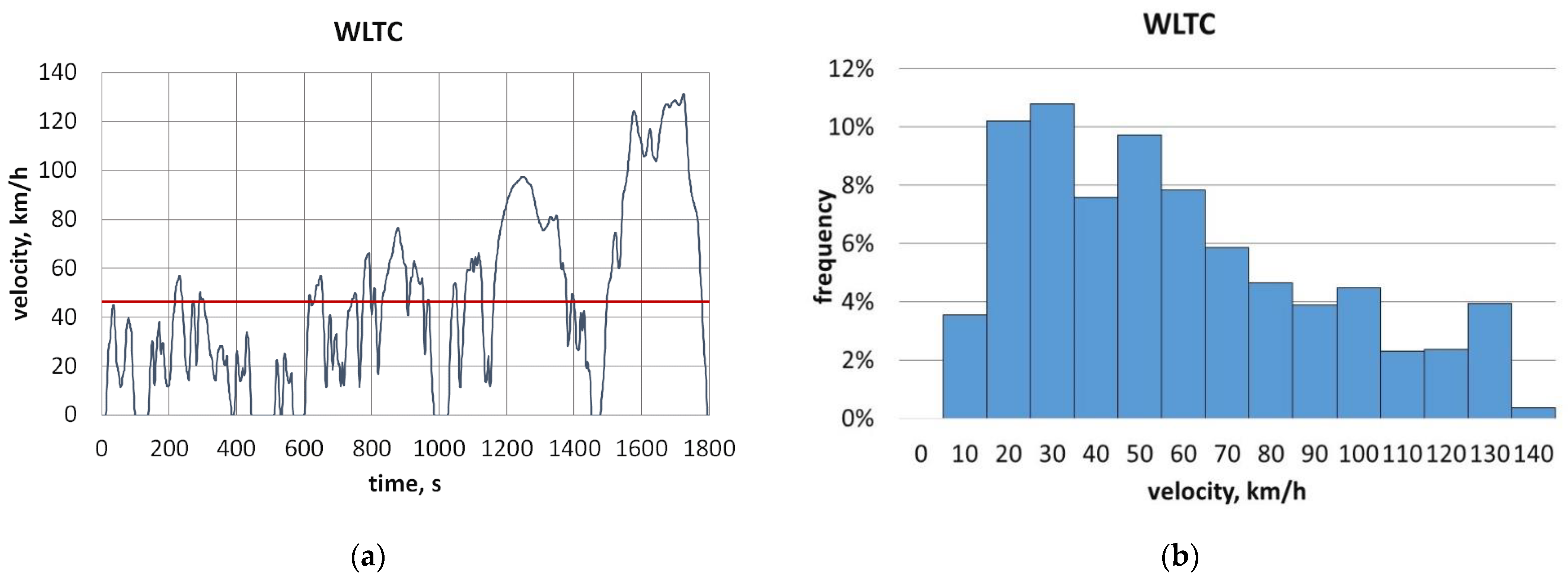
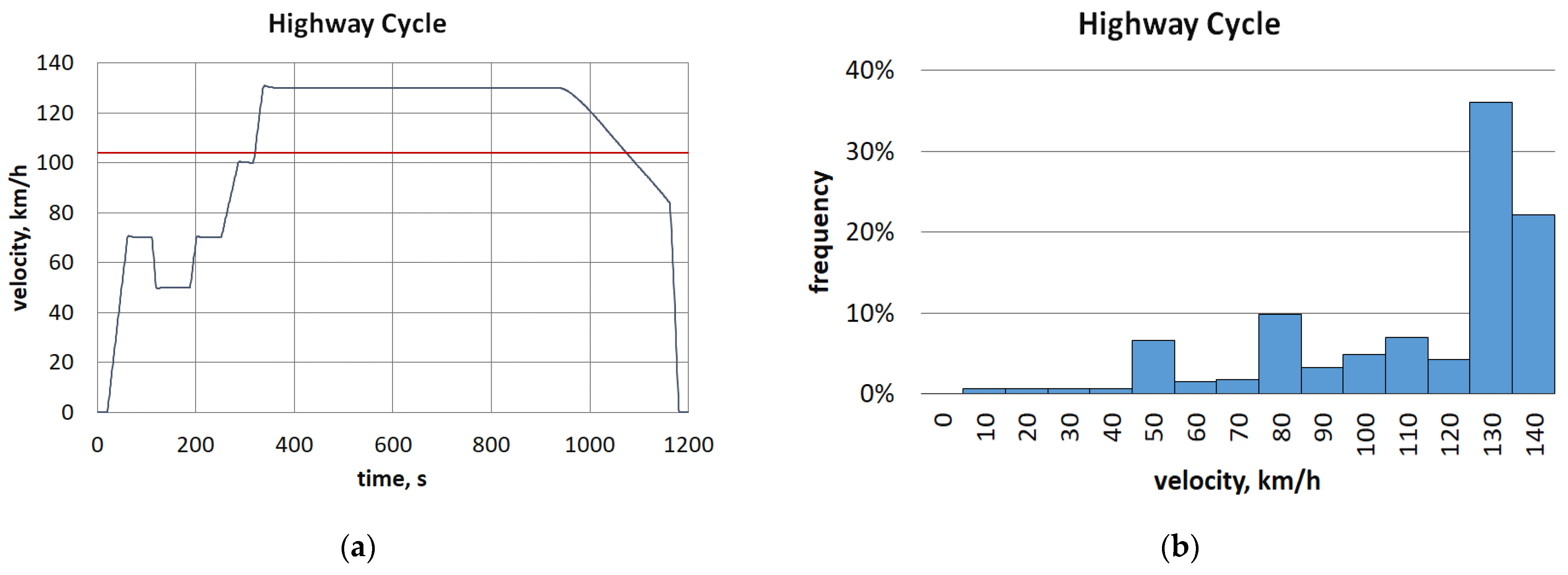
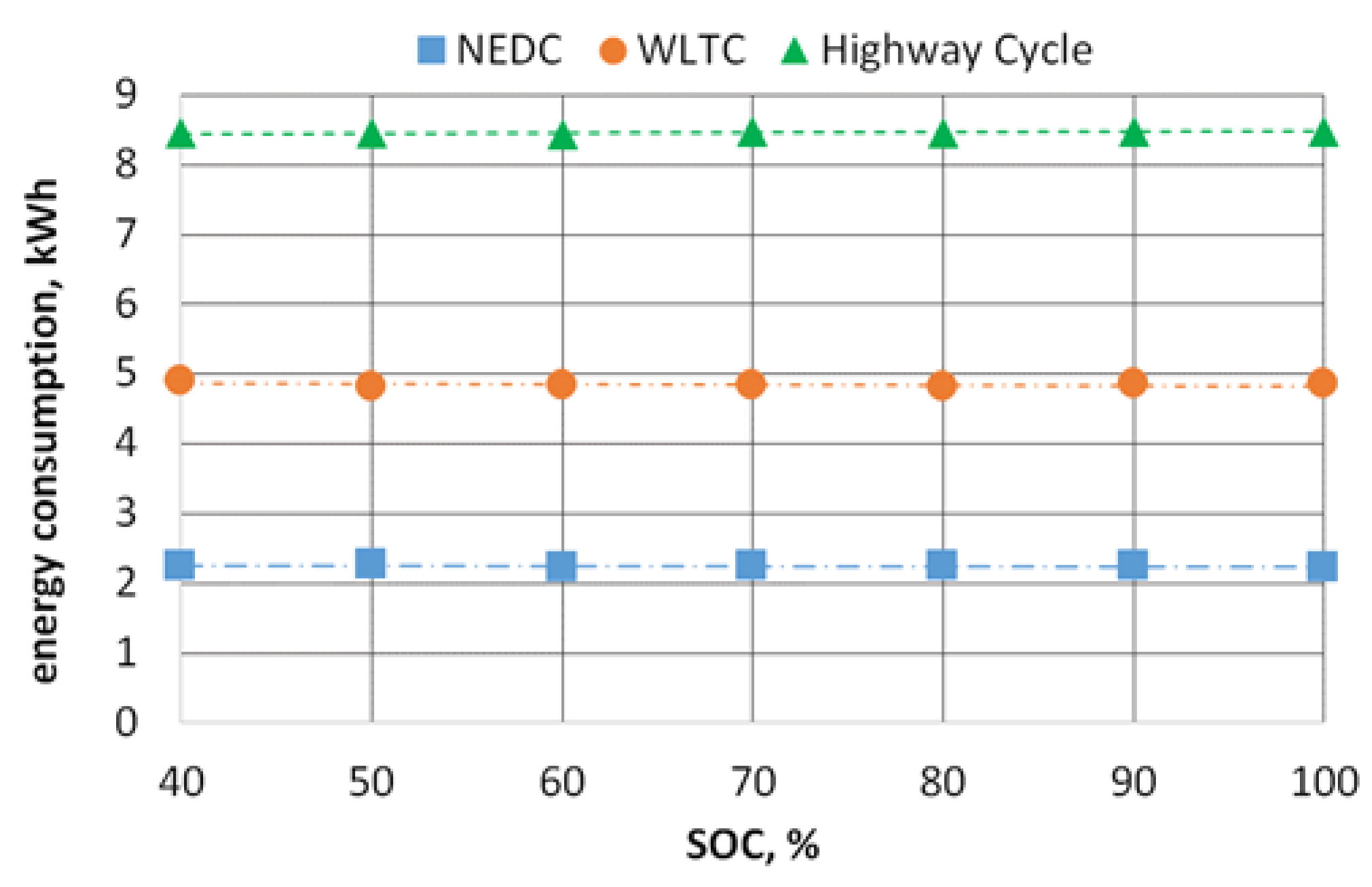
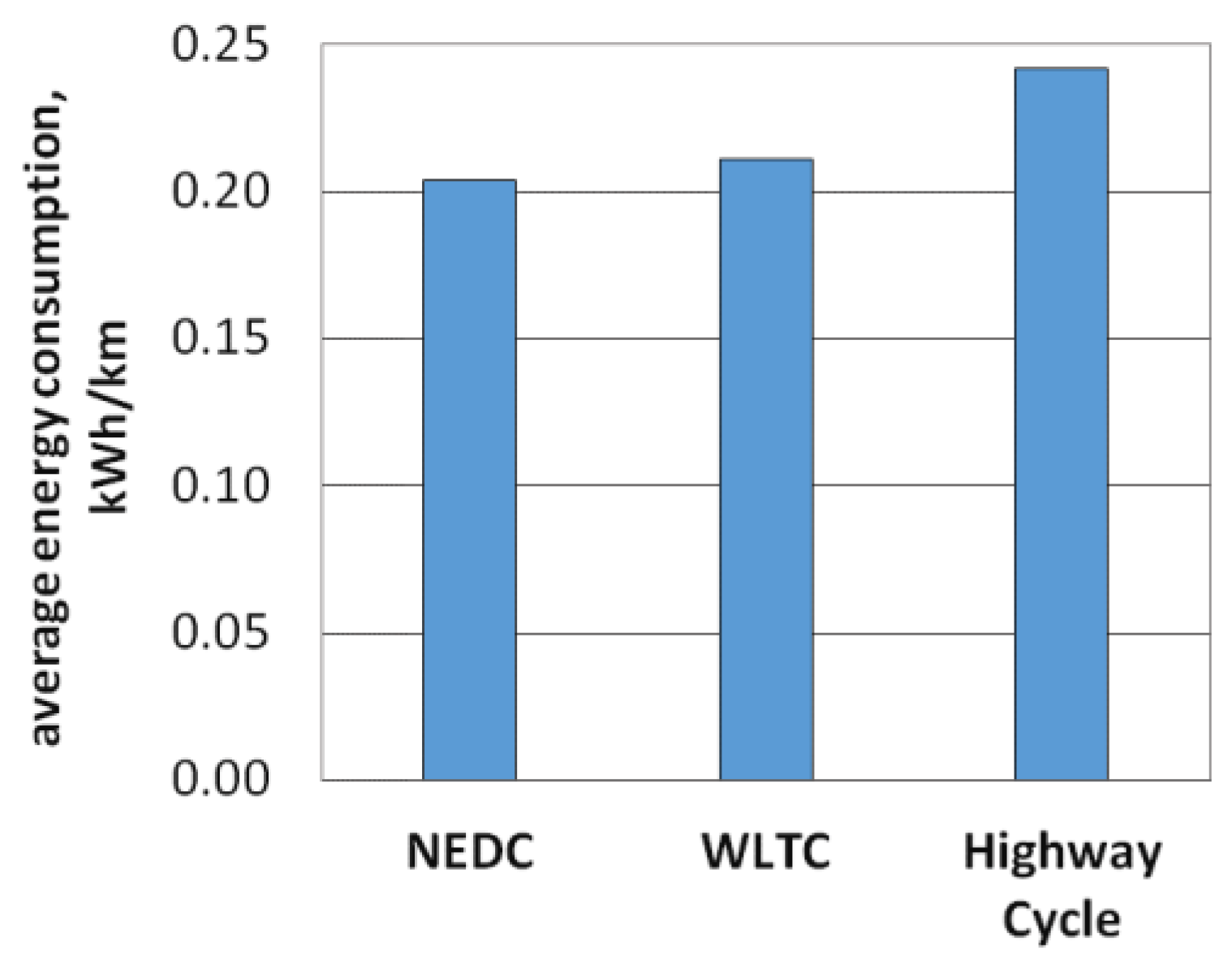

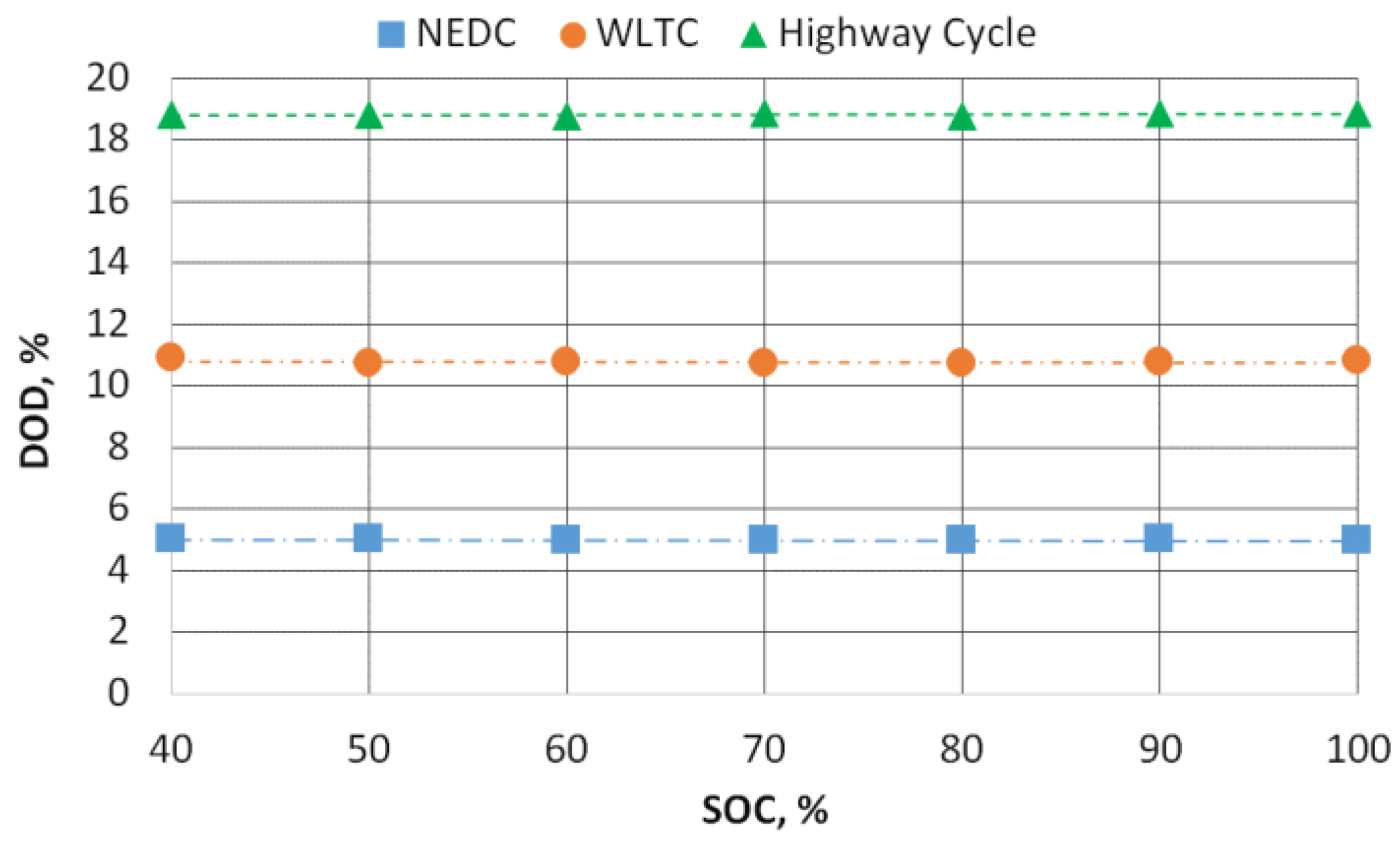

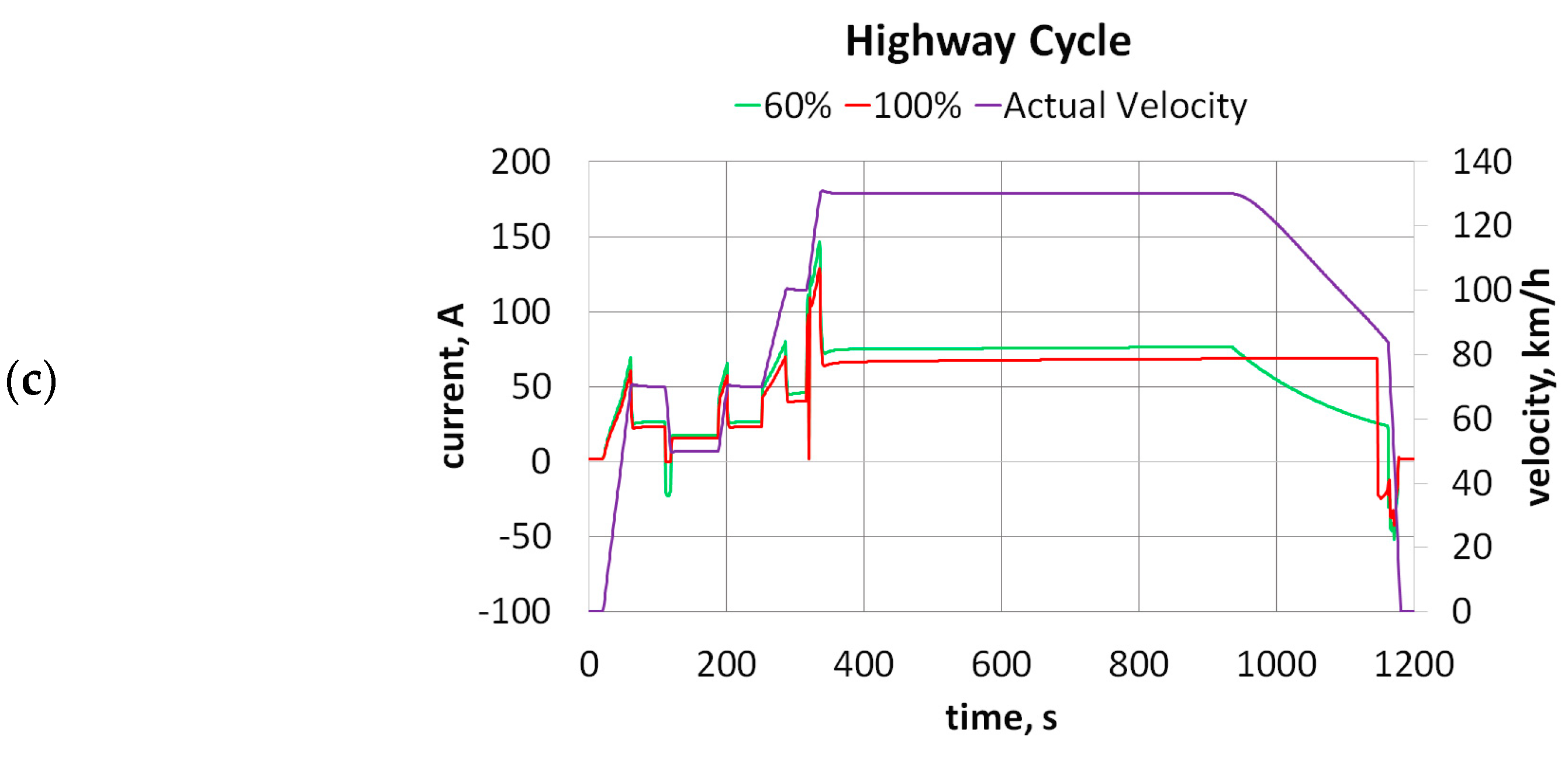
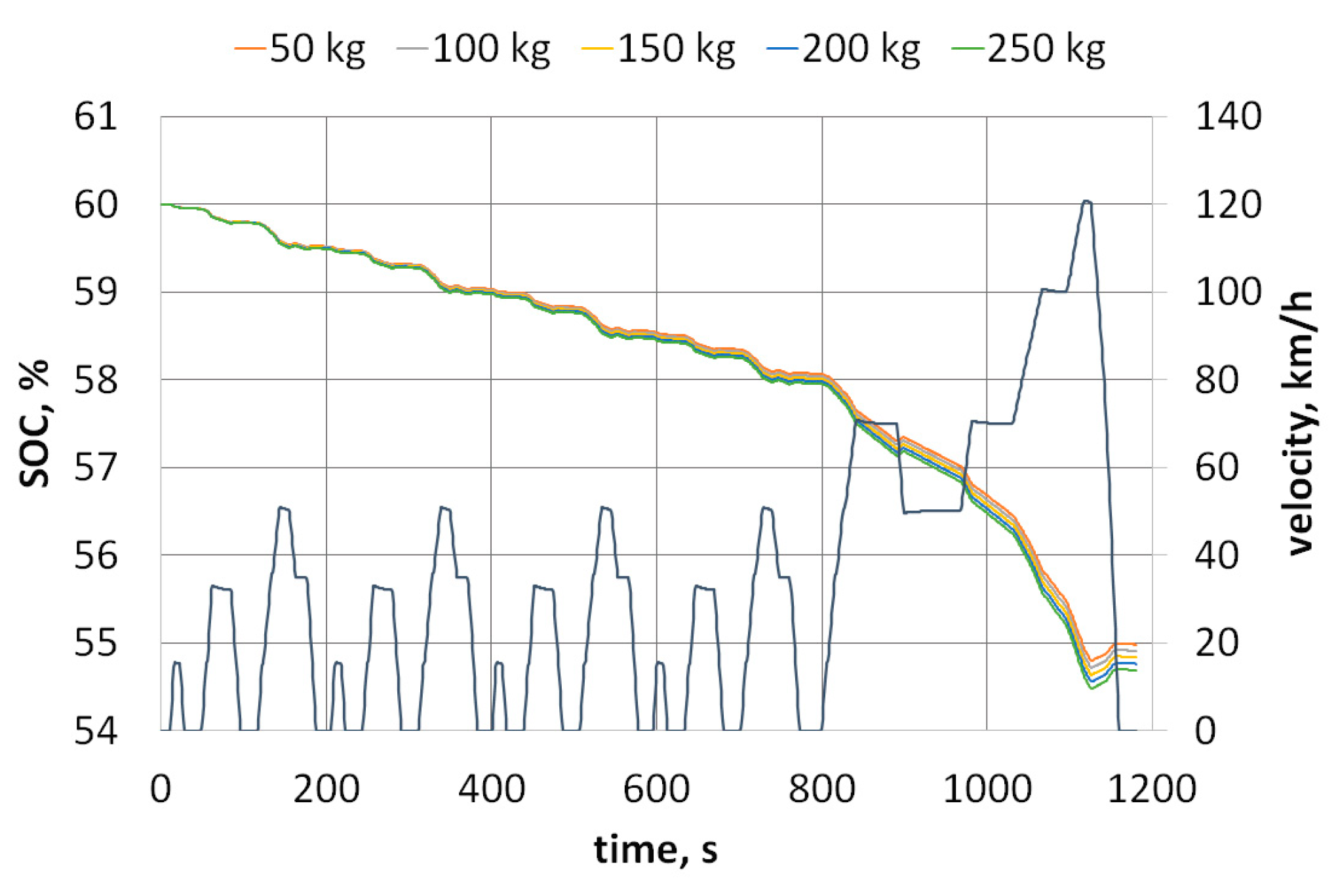
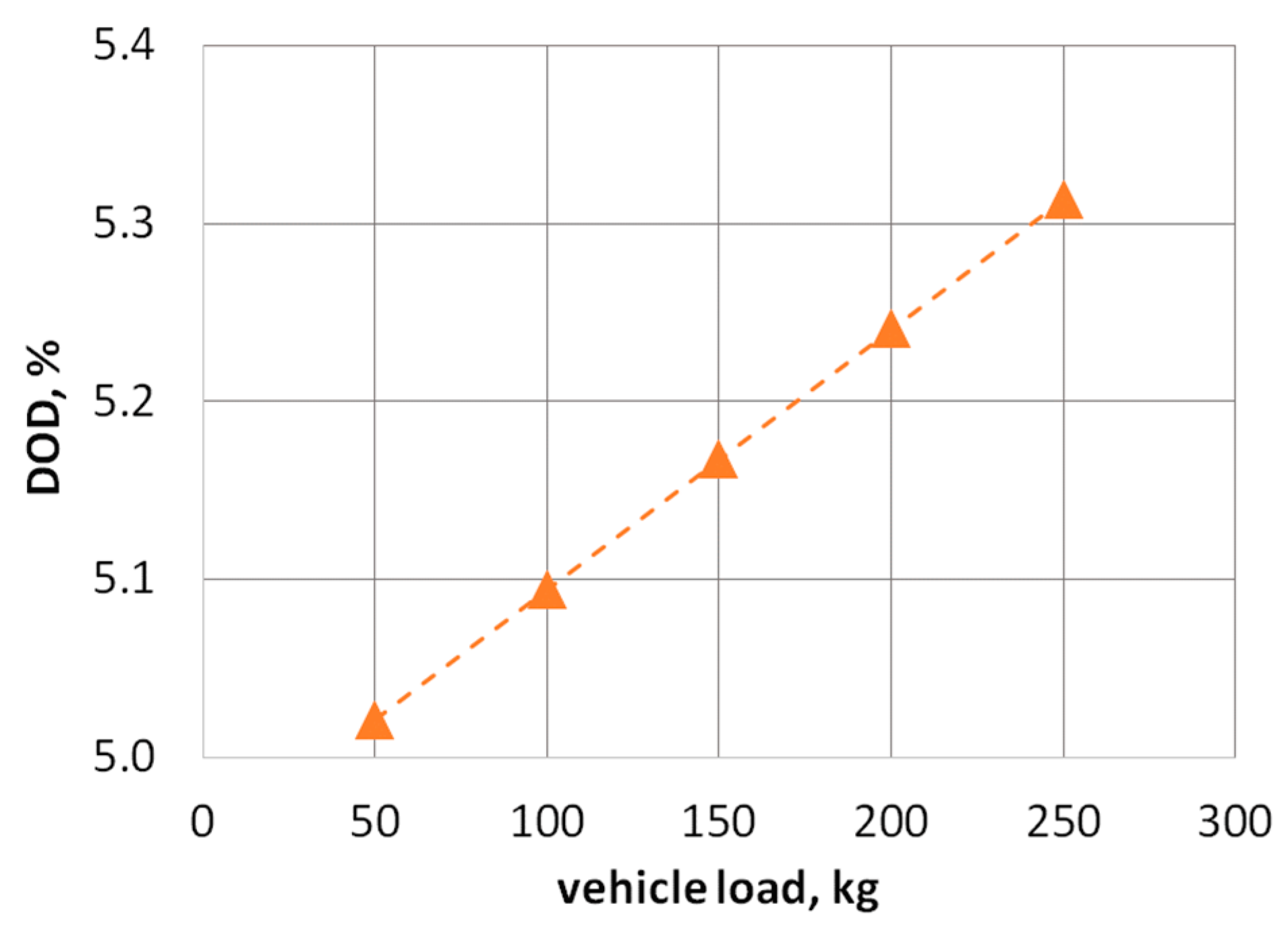
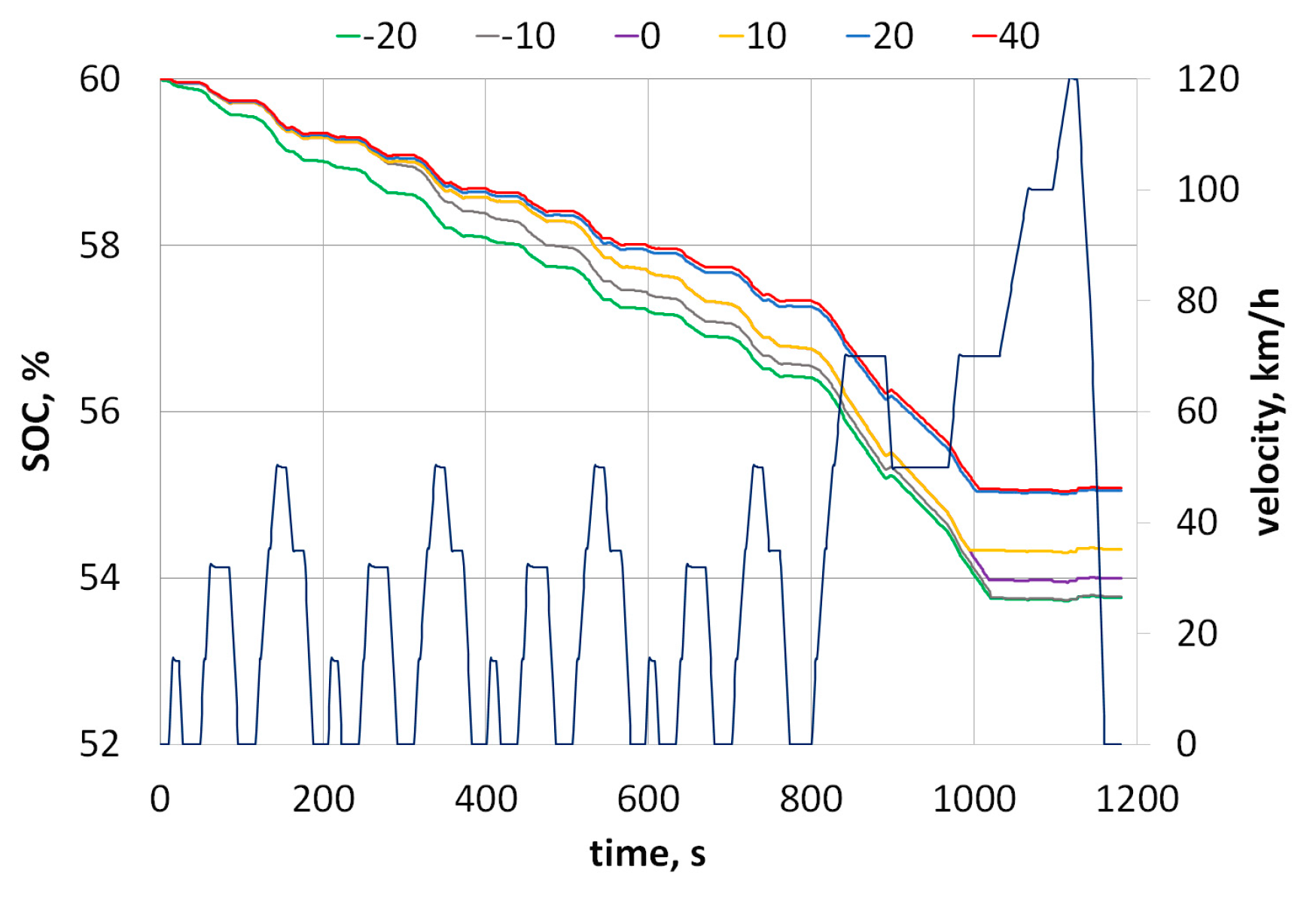
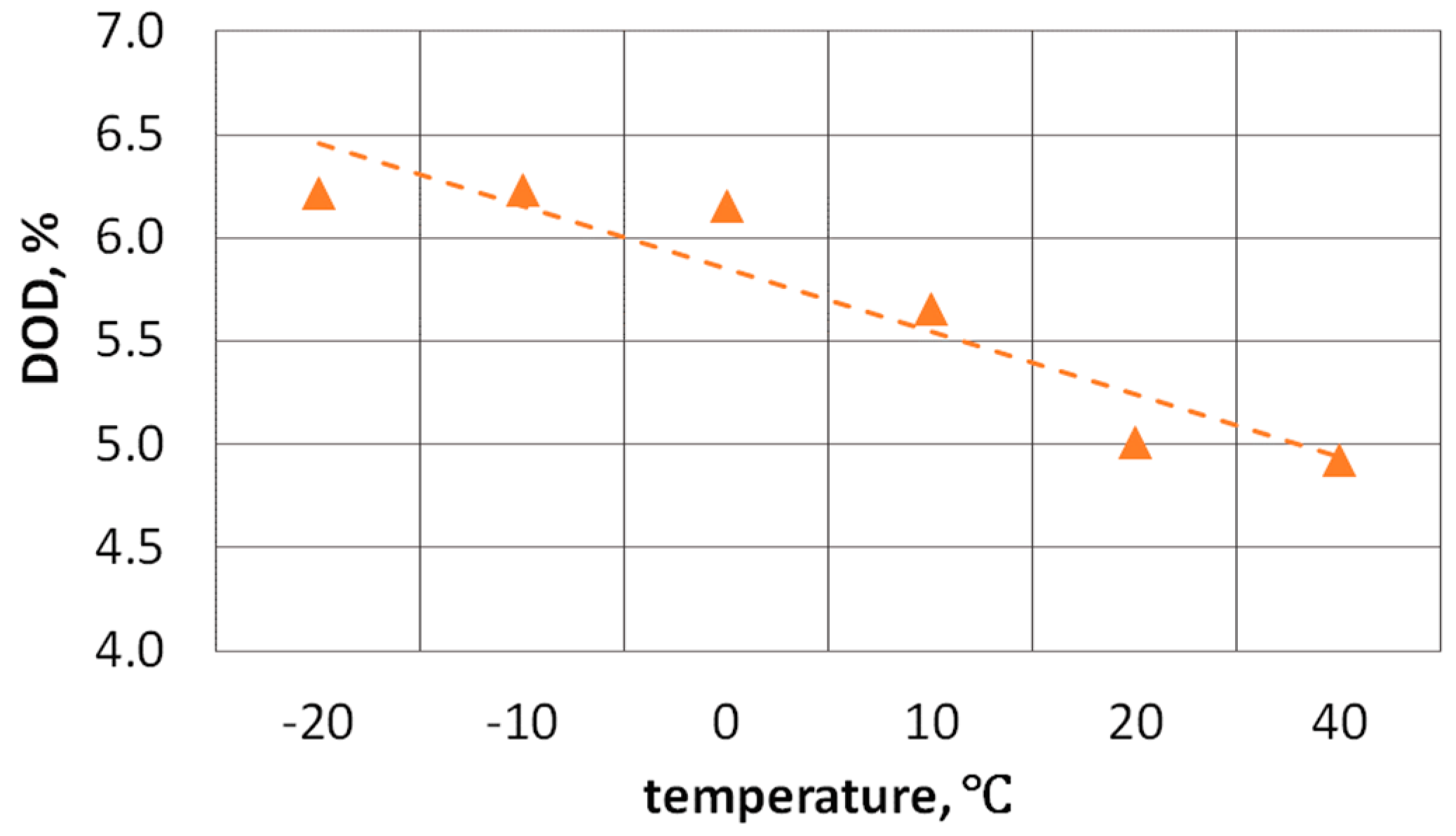
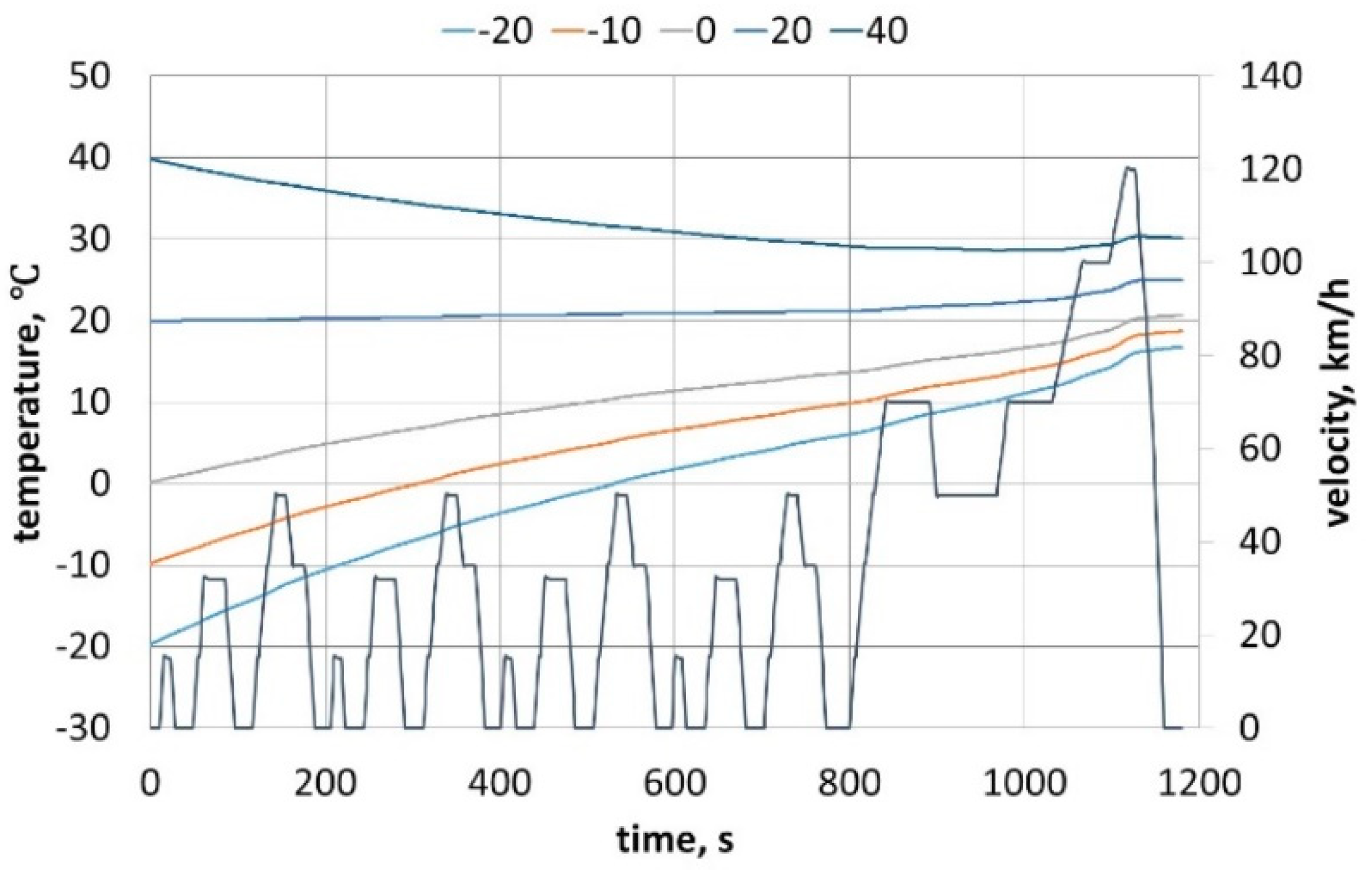
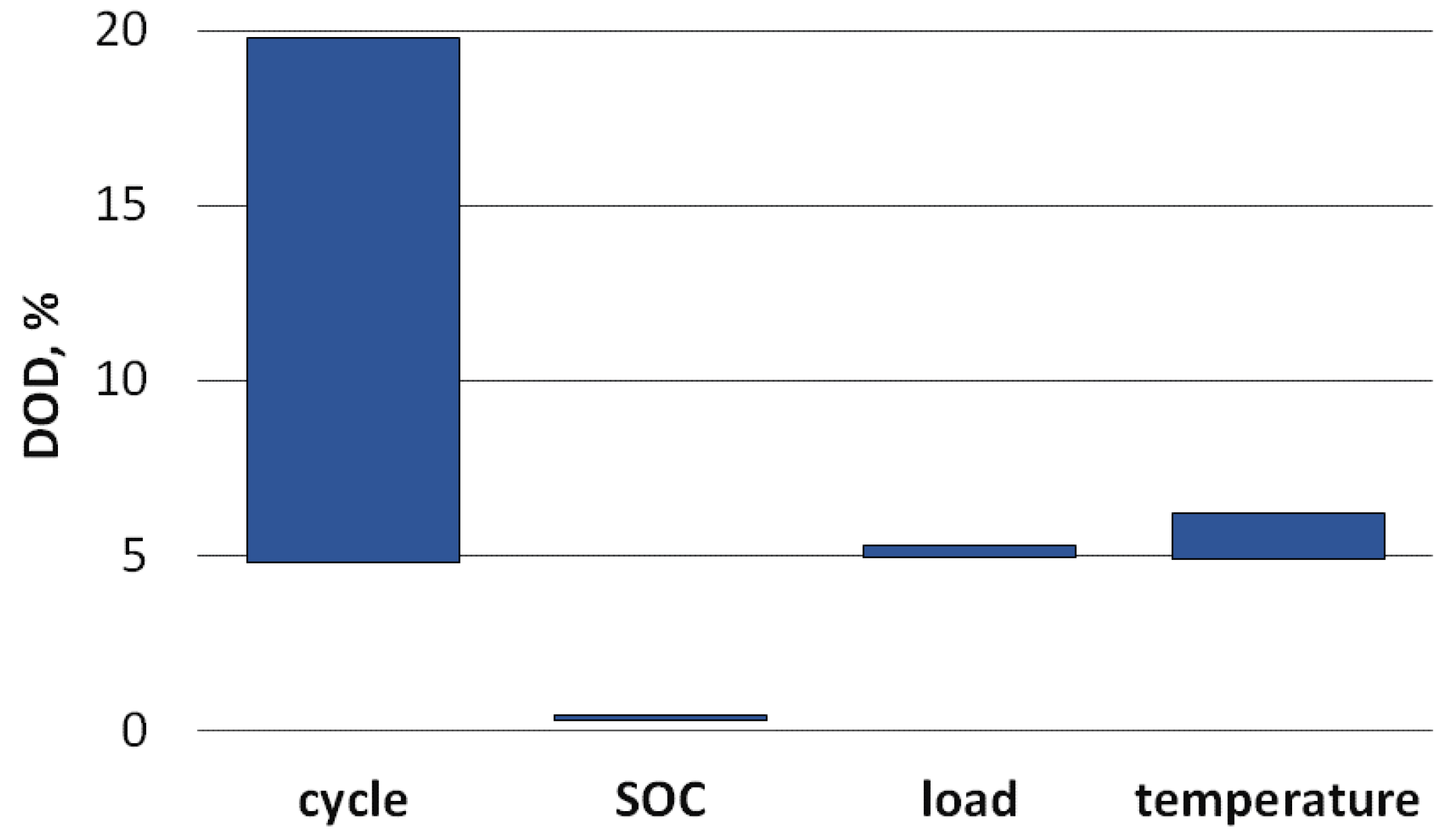
| Type of Parameters | Parameters, Units | Value |
|---|---|---|
| Vehicle | curb weight, kg | 1700 |
| gross weight, kg | 1980 | |
| frontal area, m2 | 1.97 | |
| wheel base, m | 2.77 | |
| height of gravity center, m | 0.5 | |
| drag coefficient | 0.36 | |
| Electric motor (asynchronous motor) | maximum speed, rpm | 3000 |
| maximum power, kW | 102 | |
| Li-Ion battery | energy capacity, kWh | 45 |
| maximum power, kW | 160 | |
| maximum charge, Ah | 60 | |
| maximum voltage, V | 320 | |
| number of cell per row | 120 | |
| number of cell rows | 5 |
| Parameters | NEDC | WLTC | Highway Cycle |
|---|---|---|---|
| duration, s | 1180 | 1800 | 1200 |
| distance, km | 11 | 23.25 | 35 |
| average velocity, km/h | 34 | 46 | 104 |
| maximum velocity, km/h | 120 | 131 | 131 |
| average acceleration, m/s2 | 0.53 | 0.53 | 1.34 |
| maximum acceleration, m/s2 | 1.06 | 1.67 | 1.58 |
| average deceleration, m/s2 | −0.75 | −0.58 | −1.41 |
| maximum deceleration, m/s2 | −1.39 | −1.50 | −1.49 |
| Cycle | Energy Consumption | DOD, % | |
|---|---|---|---|
| Total, kWh | Average, kWh/km | ||
| NEDC | 2.23 | 0.20 | 4.95 |
| WLTC | 4.74 | 0.21 | 10.75 |
| Highway Cycle | 8.43 | 0.24 | 18.74 |
| Temperature, °C | −20 | −10 | 0 | 10 | 20 | 40 |
|---|---|---|---|---|---|---|
| total energy consumption, kWh | 2.93 | 2.81 | 2.64 | 2.60 | 2.23 | 2.27 |
| average energy consumption, kWh/km | 0.27 | 0.26 | 0.24 | 0.24 | 0.20 | 0.21 |
| differences in average energy consumption, % | 23.89 | 20.64 | 15.53 | 14.23 | − | 1.76 |
| DOD, % | 6.23 | 6.22 | 6.15 | 5.65 | 4.95 | 4.92 |
| Load, kg | 50 | 100 | 150 | 200 | 250 |
|---|---|---|---|---|---|
| total energy consumption, kWh | 2.23 | 2.26 | 2.29 | 2.36 | 2.39 |
| average energy consumption, kWh/km | 0.20 | 0.21 | 0.21 | 0.22 | 0.22 |
| differences in average energy consumption, % | – | 1.33 | 2.62 | 5.51 | 6.69 |
| DOD, % | 4.95 | 5.02 | 5.09 | 5.17 | 5.24 |
| SOC, % | 40 | 50 | 60 | 70 | 80 | 90 | 100 |
| total energy consumption, kWh | 2.26 | 2.25 | 2.23 | 2.24 | 2.24 | 2.25 | 2.25 |
| average energy consumption, kWh/km | 0.21 | 0.21 | 0.20 | 0.20 | 0.20 | 0.21 | 0.21 |
| differences in average energy consumption, % | −1.35 | −0.90 | − | −0.45 | −0.45 | −0.90 | −0.90 |
| DOD, % | 5.03 | 5.01 | 4.95 | 4.96 | 4.98 | 5.00 | 5.01 |
Publisher’s Note: MDPI stays neutral with regard to jurisdictional claims in published maps and institutional affiliations. |
© 2021 by the authors. Licensee MDPI, Basel, Switzerland. This article is an open access article distributed under the terms and conditions of the Creative Commons Attribution (CC BY) license (https://creativecommons.org/licenses/by/4.0/).
Share and Cite
Szumska, E.M.; Jurecki, R.S. Parameters Influencing on Electric Vehicle Range. Energies 2021, 14, 4821. https://doi.org/10.3390/en14164821
Szumska EM, Jurecki RS. Parameters Influencing on Electric Vehicle Range. Energies. 2021; 14(16):4821. https://doi.org/10.3390/en14164821
Chicago/Turabian StyleSzumska, Emilia M., and Rafał S. Jurecki. 2021. "Parameters Influencing on Electric Vehicle Range" Energies 14, no. 16: 4821. https://doi.org/10.3390/en14164821
APA StyleSzumska, E. M., & Jurecki, R. S. (2021). Parameters Influencing on Electric Vehicle Range. Energies, 14(16), 4821. https://doi.org/10.3390/en14164821







